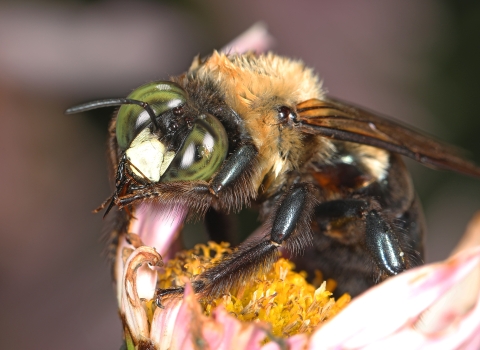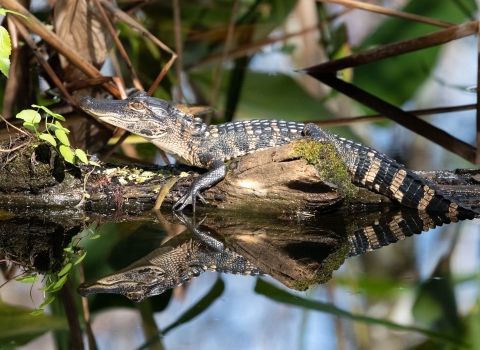What is the U.S. Fish and Wildlife Service proposing?
The Service is proposing to remove the snail darter from the Endangered Species Act (ESA) due to recovery.
What is a snail darter?
Snail darters are small fish that grow to 2 ½ to 3 ½ inches long. They eat insects and mostly snails, hence their name. They are found in rivers and streams in Alabama, Georgia, Mississippi and Tennessee.
Why is the Service proposing this action?
After an extensive review of the best scientific and commercial information available, the Service found the snail darter is no longer in danger of extinction. The recovery of the snail darter is due to relocations to other bodies of water, discovery of new populations, and partnerships between federal and state agencies. One of those key conservation partnerships involved the Tennessee Valley Authority’s Reservoir Release Improvement Program, which has benefited snail darters and countless other wildlife that also rely on clean water.
What is the history of the snail darter under the ESA?
The Service listed the fish as endangered in 1975 due to the threat of a proposed impoundment for the Tennessee Valley Authority’s (TVA) Tellico Dam, near Lenoir City, Tennessee. At that time, it was the only known location of the fish. Conservationists sued to stop the dam from being completed because it would likely lead to the extinction of the snail darter. This was the first ESA case to reach the Supreme Court. In 1978, the court ruled in favor of protecting the snail darter.
Congress then passed an amendment exempting the Tellico Dam from ESA consultation requirements so that the dam could be completed. President Jimmy Carter signed the bill into law in 1979.
Meanwhile, snail darters were collected from the Little Tennessee River and transplanted to the Hiawassee and Holston rivers in Tennessee and then to other locations. Collaborative survey efforts with TVA and state partners also found the fish in several additional streams. The snail darter can now be found in Alabama, Georgia, Tennessee, and Mississippi.
TVA has since implemented a Reservoir Release Improvement Program that has improved habitat and water quality below many TVA dams. This has benefitted not just snail darters, but other aquatic species.
In 1984, the snail darter was downlisted from endangered to threatened due to successful relocations and the discovery of new populations. Designated critical habitat was also rescinded at that time.
If the snail darter is delisted, will any protections for the darter remain in place?
If the rule becomes final, state water quality and wildlife laws will continue to protect the snail darter and its habitat. In addition, its range overlaps with other federally protected aquatic animals, so its habitat will not be affected.
Will the Service continue to monitor the darter if it is delisted?
The Service will coordinate with other federal agencies, state resource agencies, interested scientific organizations, and others as appropriate to develop and implement an effective post-delisting monitoring plan for the darter.
How can the public comment on this proposal?
The Service will accept comments received or postmarked on or before November 1, 2021. Comments submitted electronically using the Federal eRulemaking Portal (see the addresses section, below) must be received by 11:59 p.m. Eastern Time on the closing date. We must receive requests for public hearings, in writing, at the address shown in the contact section below by November 15, 2021.
Addresses
You may submit comments by one of the following methods:
(1) Electronically: Go to the Federal eRulemaking Portal. In the Search box, enter FWS–R4–ES–2020–0152, which is the docket number for this rulemaking. Then, click on the Search button. On the resulting page, in the Search panel on the left side of the screen, under the Document Type heading, check the Proposed Rule box to locate this document. You may submit a comment by clicking on “Comment Now!”
(2) By hard copy: Submit by U.S. mail or hand-delivery to: Public Comments Processing, Attn: FWS–R4–ES–2020–0152, U.S. Fish and Wildlife Service, MS: BPHC, 5275 Leesburg Pike, Falls Church, VA 22041–3803.
We request that you send comments only by the methods described above. We will post all comments on regulations.gov This generally means that we will post any personal information you provide us.
Availability of supporting materials: This proposed rule and supporting documents (including references cited and the 5-year review) are available at regulations.gov under Docket No. FWS–R4–ES–2020–0152, and at the Tennessee Ecological Services Field Office, 446 Neal Street, Cookeville, Tennessee, 38506.
Persons who use a telecommunications device for the deaf (TDD) may call the Federal Relay Service at 800–877–8339.


